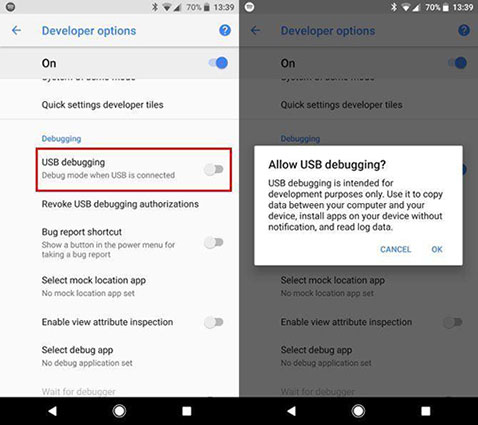
Serial Port Usb Android Debugging
This is the configuration screen for PuTTY: Click Serial (1) then enter the COM port number (2) then click Open (3). Mac - using screen Find the serial port that is being used using the Terminal program command line: ls /dev/cu.usb* It should return something like /dev/cu.usbmodemFD1161. Then issue the command: screen /dev/cu.usbmodemFD1161 Screen allows you you both send characters to the Photon or Electron as well as receive them from the USB serial device. Linux - using screen Find the serial port that is being used using the Terminal program command line: ls /dev/ttyACM* It should return something like /dev/ttyACM0. Then issue the command: screen /dev/ttyACM0 Screen allows you you both send characters to the Photon or Electron as well as receive them from the USB serial device.

Android phone or tablet with USB OTG If your Android phone supports USB OTG (“on the go”) and you have an OTG adapter cable, you may be able to use it for debugging serial! One caveat is that your phone probably won’t power up a Photon, so this will probably only work if you have an external power source, like an Electron or Photon with a battery. Install the “Android USB Serial Monitor Lite” application from the Google Play store. Connect the device to your phone using a USB cable and a USB OTG adapter. Open the serial monitor app and it should ask if you want to connect to the device. Tap yes and you should see a screen in the picture above. Configuration using USB Serial If the Photon is in listening mode (blinking dark blue), configuration can also be done using the USB Serial port.
Each of these commands only requires that you type the command letter (case-sensitive): • i - Prints the device ID (24 character hexadecimal string) • f - Firmware update (using ymodem) • x - Exit listening mode • s - Print system_module_info • v - System firmware version • L - Safe listen mode (does not run user code concurrently with listening mode) • w - Configure Wi-Fi • m - Print MAC Address for the Wi-Fi adapter Listening mode is the default when you plug in a Photon the first time. You can also get into listening mode by holding down SETUP for about 3 seconds until the status LED blinks blue.
Advanced Serial Port Terminal is a must-have tool for every developer and programmer. This session-based multi-purpose application lets you connect to any serial port device to check, troubleshoot or debug its work and connection.
The commands other then the last two Wi-Fi related commands are also available on the Electron. Changing operating modes with USB Serial Normally you press buttons to enter listening or DFU mode on the Photon or Electron.
You can also trigger it by making a USB Serial connection at a specific baud rate. For example, on the Mac you can use this command to enter DFU mode: stty -f /dev/cu.usbmodemFD1141 14400 (The device name, cu.usbmodemFD1141 in this example, may be different on your computer.) The special baud rates are: • 14400 DFU mode (blinking yellow) • 28800 Listening mode (blinking dark blue) UART Serial When connecting to an actual serial device, you’ll be using one of the UART hardware serial ports. The Photon has one and the Electron has three UART serial ports.
 Ellery Queen - Complete Novels 38 eBooks| English| ePUB/MOBI/PDF| 66 mb Ellery Queen is both a fictional character and a pseudonym used by two American cousins from Brooklyn, New York: Daniel Nathan, alias Frederic Dannay (October 20, 1905?C September 3, 1982) and Manford (Emanuel) Lepofsky, alias Manfred Bennington Lee (January 11, 1905?C April 3, 1971), to write, edit, and anthologize detective fiction.The fictional Ellery Queen created by Dannay and Lee is a mystery writer and amateur detective who helps his father, a police inspector in New York City, solve baffling murders.
Ellery Queen - Complete Novels 38 eBooks| English| ePUB/MOBI/PDF| 66 mb Ellery Queen is both a fictional character and a pseudonym used by two American cousins from Brooklyn, New York: Daniel Nathan, alias Frederic Dannay (October 20, 1905?C September 3, 1982) and Manford (Emanuel) Lepofsky, alias Manfred Bennington Lee (January 11, 1905?C April 3, 1971), to write, edit, and anthologize detective fiction.The fictional Ellery Queen created by Dannay and Lee is a mystery writer and amateur detective who helps his father, a police inspector in New York City, solve baffling murders.
All of the devices have the Serial1 object, the main UART serial port, on the RX and TX pins. • RX means serial data received into the device • TX means serial data transmitted from the device When you connect a Photon another device, say an Arduino, the RX pin on the Photon always gets connected to the TX pin of the Arduino and vice versa. This is always the case, even if you connect two Photons by serial. The last of us ps3 iso games. The Photon actually has two and the Electron four UART serial ports.